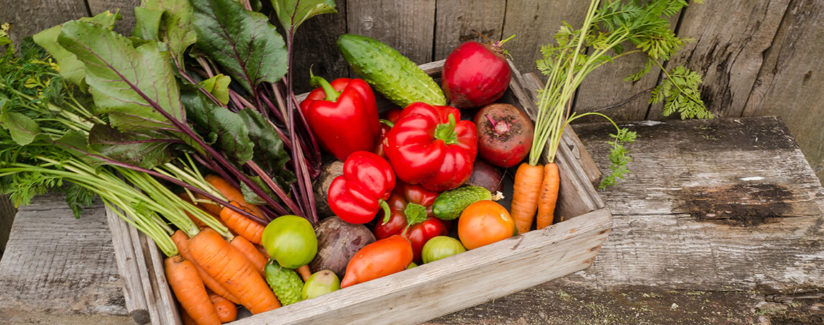
What’s the Difference Between Pesticide Free and Organic?
01/31/2019
As you are perusing the grocery store, you may notice that some foods display different labels that look, and sound, similar. Specifically, you may have questioned the difference between pesticide-free and organic labeling. Is there a difference between the two? Does one mean more than the other? We have been taking a look at common questions about pesticides – Are Pesticides Needed to Grow Food? Are Pesticides Safe for Food Consumption? Are Pesticides Safe for the Environment?
To gain some insight into the difference between pesticide-free and organic, we reached out to Dr. Paul Vincelli, Extension Professor and Provost’s Distinguished Service Professor, University of Kentucky.
What does it mean to be pesticide-free? What about organic?
Dr. Vincelli: “’Pesticide-free’ is not a strictly defined term, but it might be used to refer to crops that were not treated with any synthetic (human-made) pesticides. Pesticides are substances for controlling insects, weeds, or disease-causing organisms. ‘Organic’ commonly refers to ‘certified organic:’ agricultural products certified to have been produced in compliance with the National Organic Program (NOP) of the USDA’s Agricultural Marketing Service.”
The NOP is responsible for creating national standards for organically produced agricultural products. If a product meets their standards, they will receive the USDA organic seal; however, it should be noted that these regulations do not address food safety or nutritional value.
In order to meet the USDA organic standards, a product must contain the following criteria:
- Produced without excluded methods, ionizing radiation or sewage sludge
- Produced per the National List of Allowed and Prohibited Substances
- Overseen by a USDA National Organic Program – authorized certifying agent, following all USDA organic regulations
If something is organic, doesn’t that mean that it is pesticide-free?
Dr. Vincelli: “No. It means only that the product was produced according to the standards of the NOP. While organic growers are commonly committed to using limited to no pesticides, they can—and often do—use pesticides allowed under the NOP standards.”
Have you wondered what a pesticide is? According to Dr. Vincelli, there are three categories of substances that act to kill pests:
- Synthetic pesticides. These are pesticides created by humans. This includes substances that may be designed to mimic natural substances. These are applied to the plant in some way: as a spray, a seed treatment, etc.
- Natural pesticides applied to plants. These are pesticides made from natural substances. An example would be copper-based pesticides. Copper is mined by humans, but the copper-based active ingredient has not been created by human design. Another example would be pesticides made from naturally occurring bacteria found in the soil. These naturally occurring substances can be toxic to pests, such as spider mites, mosquitoes, ants, fruit flies and others. Spinosad is such a compound and some spinosad products are approved for use in organic agriculture. Pesticides in this category are applied to the plant in some way, much like synthetic pesticides.
- Natural, internal pesticides. These are natural chemicals synthesized internally by the living plant to defend itself against pest/disease attack. Plants are figuratively assaulted constantly by microorganisms and insects that want to consume the plant’s tissues. Since plants can’t run away to escape these attacks, they must defend themselves through chemicals. Plants are rather remarkable chemists, and defense against attack is a big reason for this.
“When people say the word, ‘pesticide,’ they almost always are thinking of category #1,” said Dr. Vincelli. “Some of the substances in category #2 are approved for use by organic producers. Even though they are natural, they are toxic to target pests—and sometimes to non-target organisms also, including humans. But since these substances are natural, many people mistakenly believe that they cannot be pesticides, but they are, because they kill or disrupt pests. A common assumption about natural substances—pesticides or not—is that, since they are natural, they must be safe. It is an easy assumption to make. I often find myself making the same assumption. However, it is an invalid assumption. The world is full of many natural substances that are hazardous to our health at some dose, even at doses we might consume.”
Dr. Vincelli continued to explain that substances in category #3 “’fly under the radar’ of public consciousness.”
Sometimes we have some scientific knowledge of the human risks of eating natural, internally produced chemical pesticides, but commonly we don’t know much about how they might impact human health,” explained Dr. Vincelli. “I am not saying we should be worried about eating plants and plant products, because of these natural, internal pesticides. To the contrary, a healthy diet includes eating at least five servings of fruits and vegetables, regardless of the possible presence of low amounts of natural, internal pesticidal chemicals. But these are in our food, naturally, and it is interesting to ponder how little we know about these natural pesticides in our diet and how much more there is to learn about eating for optimal health.”
Alright, we’ve received several reader questions about this. Is organic food safer to consume than conventionally produced food?
Dr. Vincelli: “Simple answer: I purchase and eat both conventional foods and organic foods. This is because I am generally impressed with the rigor of the regulatory process for pesticides. Most of the time our federal review and approval of pesticides by EPA is impressive and designed to protect public health while maintaining agricultural productivity. In my 35+ years of working with pesticides, I recall only one instance in which I thought the federal government was not adequately protecting public health through conservative decision-making about a pesticide. That was a recent example. But almost always, our government does an excellent job of vigorously assuring the safety of pesticides on and in our foods.”
Summary
Foods that are labeled “pesticide free” and “organic” represent different ways in which the food was grown. Pesticides include a variety of substances, some of which occur naturally and some of which may be used on organic food. Foods in the United States are tested and vigorously regulated to make sure they are safe to eat.
Other articles in this series:
Are Pesticides Needed to Grow Food?
Are Pesticides Safe for Food Consumption?
Are Pesticides Safe for the Environment?


























